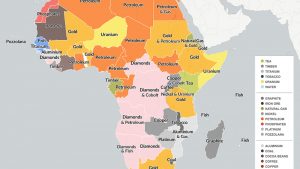 February 17, 2018//-According to a comprehensive just released World Bank book on the “wealth of nations” despite robust growth in gross wealth in Africa, per capita wealth has seen a drop, leading to some remarkable fall in prosperity – this is all largely due to soaring population growth outpacing investment in most countries in the region.
February 17, 2018//-According to a comprehensive just released World Bank book on the “wealth of nations” despite robust growth in gross wealth in Africa, per capita wealth has seen a drop, leading to some remarkable fall in prosperity – this is all largely due to soaring population growth outpacing investment in most countries in the region.
But there is also some good news. Ethiopia, Rwanda and Sierra Leone are among the low-income countries that saw wealth increased substantially, while the book also hastens to add the Democratic Republic of Congo, Madagascar, and Tanzania, however saw some stagnation.
In general in Sub-Saharan Africa per capita wealth fell by 2% in part because of declines in some of the largest countries, such as Nigeria and Tanzania, where population was also growing rapidly, and also because of slow growth in other large economies such as South Africa, reveals the book – The Changing Wealth of Nations 2018: Building a Sustainable Future.
Opening with a review of global and regional trends in wealth over the past two decades, the book provides examples of how wealth accounts can be used for the analysis of development patterns, and explains the flaw in how countries regularly track gross domestic product (GDP) as an indicator of their economic progress, but not wealth, that is – assets such as infrastructure, forests, minerals, and human capital which produce GDP.
Although Sub-Saharan Africa has been affected by a decline in total wealth per capita, the trend is mixed, with losses in a few large countries, and gains in the other, say the authors of the book which broadly presents good news. For example, global wealth grew significantly between 1995 and 2014 and “set the stage for addressing development through a comprehensive measure of wealth, which underpins income and well-being.”
However, it also highlights concern. “Some low-income countries—especially in Sub-Saharan Africa—saw a decline in per capita wealth as rapid population growth outpaced investment… in 12 countries the percentage of people living in extreme poverty has jumped over the last decade,” writes Kristalina Georgieva Chief Executive Officer World Bank in the book’s forword.
“Looking at this disturbing trend through the lens of wealth accounting shows that the ‘demographic dividend’ from population growth can be realised only with rapid investment in infrastructure and education, and by managing the natural asset base sustainably in the long run,” she added.
Of the 24 countries that have remained low-income since 1995, 13 are classified as fragile and conflict states and out of these a majority are resource-rich.
“This helps us see better the links between poverty, fragility, and governance. It is not a coincidence that several fragile countries are rich in resources but cannot at present use resource rents to build their institutions and people,” says Georgieva
Further details reveal that the share of global wealth held by low-income countries, mainly in Sub- Saharan Africa, barely moved from less than 1% throughout the period 1995–2014, “even as those countries’ share of world population grew from 6% to 8%.”
However, this result masks divergent trends in Sub-Saharan Africa. Although wealth in many countries increased substantially, these gains were offset by slower progress and in some cases losses in wealth in a few large low-income countries, such as the Democratic Republic of Congo, Madagascar, and Tanzania, it reports proffering further that investing in human capital can be a springboard for “diversification of national wealth and the economy, reducing the dependence on natural capital of many countries and the commodity-driven boom-and-bust cycles common to so many low- and middle-income countries.”
Indeed several chapters discuss new work on human capital and its application in development policy, with emphasis on how and why human capital is a key driver for development, while examining how political and economic instability take a huge toll on any country’s its human capital development, leading to a sharp fall in the wealth in populations.
The authors also report that women account for less than 40% of human capital wealth because of lower earnings, lower labour force participation, and fewer average hours of work.
“Achieving higher gender parity in earnings could generate an 18% increase in human capital wealth,” its stated.
The book also reveals that the asset value of agricultural land has gone up sharply in most countries, saying part of the gain is due to expansion of area under cultivation, especially in Latin America and Sub-Saharan Africa.
But, says the book, despite growth in the value of agriculture land in Sub-Saharan Africa, it did not keep pace with population growth in 18 of the 35 countries, and per capita agricultural land value declined .
“Significant numbers of people rely on agriculture for livelihoods in these countries, including in Cote d’Ivoire, Gabon, Ghana, Mali, Nigeria, Tanzania, and Zambia. By contrast, significant gains were achieved in Ethiopia, The Gambia, Mozambique, Namibia, Togo, and Uganda,” one chapter reads.
And another whole chapter devoted to a case study of Morocco, addresses the role of intangible capital in powering the country’s development in the context of the Morocco 2040 strategy – looking into priorities for growth and macroeconomic reforms, including areas such as education and (again) the promotion of human capital and opportunities to increase gender equality, and institutional reforms.
In summing, the book concludes: “The challenge for Sub-Saharan Africa in the next decade will be to harness the benefits of the demographic dividend so that standards of living can rise more rapidly without depleting natural capital. Doing so will require substantial investments in all assets, especially in the human capital needed for growth.”
africanbusinessmagazine.com


